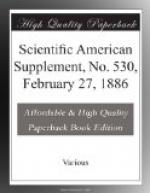[Illustration: PRIZE PLAN FOR THE NEW BOOK EXCHANGE IN LEIPZIG, BY MESSRS. KAYSER AND VON GROSSHEIM, ARCHITECTS.]
To the left of the principal hall in the main building, which has three large ornamental windows, there is a little hall, the central office, and committee rooms, while the restaurant and the assembly rooms are on the right. In the smaller building, through which there is a central corridor, are the order rooms, assorting rooms, editorial sanctum of the Borsenblat (Bourse journal), and the post office, with telegraph offices.
A low building runs almost the entire length of the main building, to which it is joined at the right and left by side wings, thus inclosing an open court. In this low building the exhibition rooms are arranged, and in the middle is a vestibule through which these exhibition rooms, the wardrobes, and the great hall can be reached. Over the vestibule is a cupola.
The arrangements for lighting, heating, and ventilation are excellent. Steam heat is used, and the large hall is ventilated by the pulsation system.
The building, which is of red brick and sandstone, is worthy of holding a place among the numerous beautiful buildings which have been erected in Leipzig during the last few years. The cost of the building was limited to 700,000 M., or about $160,000.
* * * * *
A correspondent has transmitted to the editor of L’Union Pharmaceutique the prospectus of an oyster dealer who, besides dealing in the ordinary bivalves, advertises specialties in medicinal oysters, such as “huitres ferrugineuses” and “huitres au goudron.” The “huitres ferrugineuses” are recommended to anaemic persons, and the “huitres au goudron” are said to replace with advantage all other means of administering tar, while of both it is alleged that analyses made by “distinguished savants” leave no doubt as to their valuable qualities.
* * * * *
ALIZARINE DYES.
Notwithstanding the unprecedented progress of the coal-tar dyestuff industry during the past few decades, the time-honored indigo, logwood, fustic, etc., have been only partly displaced by the coal-tar products in wool dyeing. The cause is that, though the dyer handled many aniline dyestuffs which dyed as fast against light as logwood or fustic, the dye proved unsatisfactory for fulling goods, because it bled in the treatment with soap and soda, and often more or less changed its tone. We intend to render a service to our readers by calling their special attention to some products of the coal-tar industry which are free from these defects of aniline dyestuffs, and for which it is claimed that they far surpass logwood, fustic, cudbear, etc., as to fastness against light, and excellently stand fulling. We allude to the alizarine dyestuffs, which have long since been introduced and are largely employed in cotton dyeing and printing.




